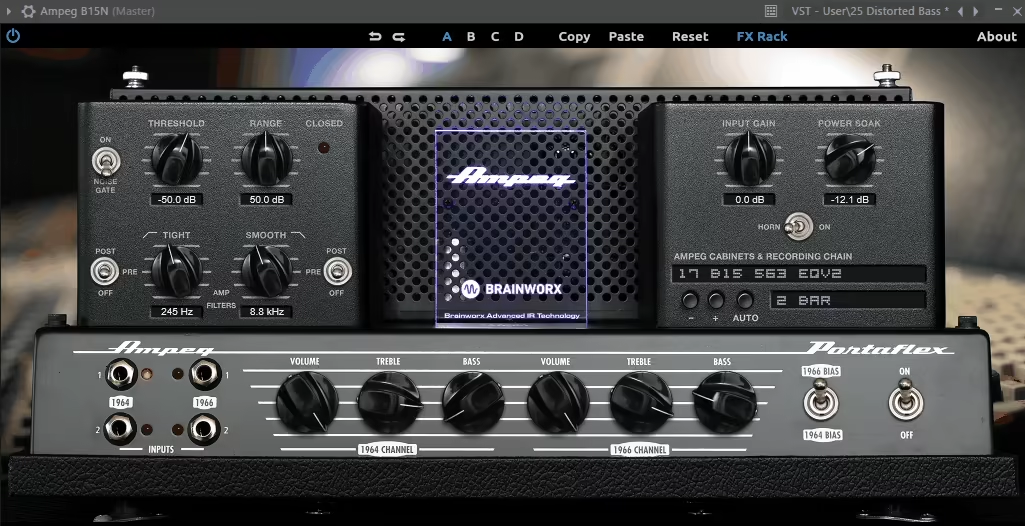There’s a particular kind of warmth that only an old Ampeg can give you – that thick, cushiony low-end that seems to hug the mix instead of just sitting in it.
When Universal Audio released their UAD Ampeg B-15N, I honestly wasn’t expecting to get that same kind of tactile, vintage saturation from a plugin. But after a few hours with it, I started forgetting I wasn’t playing through a real cab. It captures that syrupy midrange bloom and slightly compressed, rubbery feel that made the original B-15 such a studio favorite back in the Motown era…
What really got me is how reactive this thing is. I plugged my passive Precision Bass straight into my Apollo, switched on Unison mode, and immediately noticed how alive it felt. The plugin responds to touch in a way that’s surprisingly organic – dig in a bit and you get that lovely bite, back off and it melts into a buttery sustain.
The Unison technology is doing serious work here, letting your instrument load the input like it would with the actual amp’s impedance. That’s one of those under-the-hood things that just makes it feel right under your fingers!
I gravitated toward the 1966 model channel for its slightly firmer bottom end, but the ’64 model has that looser, more pillowy tone that sits beautifully under old-school soul tracks. The EQs aren’t identical between the two either, which is cool – the tonal differences feel subtle but meaningful…
You can even mix and match the bias from one model to the other, which, to be honest, is the kind of nerdy flexibility that I love about digital gear. On a real amp, biasing tubes requires a screwdriver, nerves of steel, and a healthy respect for high voltage. Here, it’s just a knob twist away.
Main Features:
- Authentic Ampeg Heritage Emulation: Faithfully models the legendary B-15N bass combo amp, officially endorsed by Ampeg and based on the limited-edition Heritage reissue.
- Dual Vintage Circuits (’64 & ’66 Models): Switch between the softer, rounder 1964 cathode-biased design or the punchier, higher-headroom 1966 fixed-bias version.
- Classic Baxandall EQ Section: Delivers the smooth, musical low and high-frequency shaping that defined countless Motown and Stax recordings.
- Integrated Brainworx FX Rack: Fine-tune your tone with a noise gate, Power Soak for controlled tube drive, and pre/post switchable Tight (HPF) and Smooth (LPF) filters.
- Premium Recording Chains: Choose from 42 expertly captured cabinet and mic setups recorded in a Neve-equipped studio, complete with Horn switch for added realism.
The FX rack is a great bonus. The noise gate is simple but useful, especially if you’re stacking compression afterward. I’d say go easy with it though – too much and you’ll shave off the natural tail of your notes. The “Tight” and “Smooth” filters (basically high-pass and low-pass) sound good, but I do wish they were labeled more clearly.
Calling them that feels unnecessarily cute. Still, the option to place them pre- or post-amp gives a lot of tonal control. You can clean up the low-end before hitting the amp for a tighter response, or filter post for a more authentic cabinet roll-off feel.
And speaking of cabinets – the 42 mic and cab combinations are where the rabbit hole opens up. Brainworx clearly went all out here. Some of those combinations sound massive, especially when you blend ribbon and condenser mic chains.
There’s even an “Empty Play Real Cab” mode that simulates running the amp straight into a console, which is perfect for re-amping or layering DI bass. I found myself cycling through the mic chains mid-session using their “auto-audition” feature, which is a godsend for comparing tones without clicking through menus.
From a practical standpoint, it’s a very usable plugin. It loads fast, doesn’t hammer the CPU, and stays consistent across sessions. I’ve been using it not just on bass, but occasionally on synths too – if you send a mono synth bass through it and crank the input, it adds this chewy analog thickness that’s hard to fake with saturation plugins.
Now for the downsides. The interface feels a little cramped if you’re on a smaller screen, and the labeling choices (like those “Tight” and “Smooth” filters) don’t really help clarity. It also doesn’t do everything – this isn’t your go-to amp if you need modern, snappy, extended highs or ultra-clean tones. The B-15 sound is colored, vintage, and unapologetically narrow in its sweet spot. But that’s kind of the point..
After a week of testing, I’d say the UAD Ampeg B-15N isn’t about versatility. It’s about character. It’s about capturing a tone that instantly feels like it’s been on tape for decades. There’s a reason that amp defined an era of bass sound – it’s smooth, musical, and plays well with other instruments.
Pros
- Exceptionally authentic tone: Captures the warm, rounded low-end and syrupy midrange that define the original Ampeg B-15 sound.
- Highly responsive feel: Unison technology delivers realistic playing dynamics, reacting naturally to touch and pickup output.
- Dual vintage models: Offers both ’64 (soft and warm) and ’66 (punchier, tighter) versions with distinct EQ behavior and bias flexibility.
- Deep tonal shaping: Brainworx FX rack adds noise gate, filters, power soak, and flexible cab/mic options for nuanced control.
- Studio-ready sound design: 42 cab/mic setups and consistent low CPU load make it reliable for both tracking and mixing.
Cons
- Limited tonal range: Not ideal for modern, ultra-clean, or hi-fi bass tones; excels mainly at vintage character sounds.
- Cramped interface: UI feels tight on smaller screens, with some unclear labeling (like “Tight” and “Smooth” filters).
- Easily over-gated: The noise gate can cut off sustain and natural note decay if pushed too far.
- Not a one-size-fits-all amp: Its signature tone may be too colored for genres outside of vintage, soul, or classic rock contexts.
Verdict
This isn’t a “do-it-all” bass amp, but it doesn’t need to be. The UAD Ampeg B-15N nails the vibe of the original – warm, soulful, and responsive. It’s a faithful emulation with modern touches that make it easier to work with, without killing the charm!
A few naming quirks aside, it’s one of the most satisfying bass amp plugins I’ve played through. If your mixes need that vintage, tube-glow depth, this one’s worth living inside for a while.

We are plugin nerds (just like you!). We made this website to keep you updated on the latest trends, news and everything plugin related.

